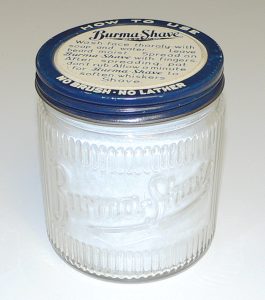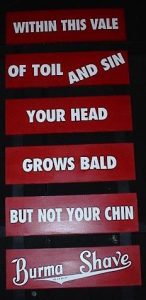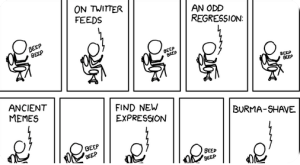
Burma Shave was a shaving cream sold by the jar, about the size of a jar of cold cream. It was a brushless shaving cream, competitive with similar shaving creams put out by Noxzema and Barbasol at the time. His brand was contemporary with these, first made in 1925 by the Burma Vita company of Minneapolis, Minnesota.
In 1927, an advertising campaign was started by founder Clinton Odell, where short signs would be placed in regular intervals along the right side of highways. Each of the six short signs would contain the line of a possibly humorous rhyming poem, followed by the product name, Burma Shave.

Given that the vehicles of those days were either farily slow, or were of the horse-and-buggy variety, they were a way to keep the brand name in your head. It can be stated that billibard signs were not nearly as common yet. But after the Interstate system was built, and cars started to outmode the hose-drawn carriages, these signs got more expensive to maintain as there were much cheaper ways to advertise, including by radio and TV, which became popular after the 1950s.
By 1963, these signs were taken down across the United States, and many of them were donated to The Smithsonian Institute as cultural artefacts. Philip Morris, makers of the popular Marlboro cigarettes, purchased the company that year, the brand held its own over several decades, but soon faded by the end of the 20th century. By the 1990s, they were sold to the American Safety Razor Company, and an attempt was made to reintroduce the brand in 1997. However, the marketing landscape had changed radically by then, and Walmart had dropped products from that company from its lineup, and by 2010 The American Safety Razor Company had to file for bankruptcy.

But the cultural phenomenon they will always be known for are those signs — which have now been called “motion graphics” — not that the signs themselves were moving, but that instead the graphic required the viewer to move to see the successive signs.
For additional discussion about Burma Shave, you can surf here.
Visits: 126

If you forgot
To shave your face today
There’s one thing
We have to say:
Burma Shave